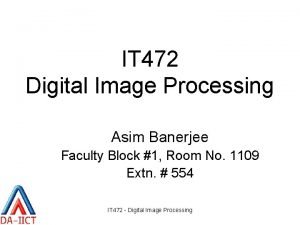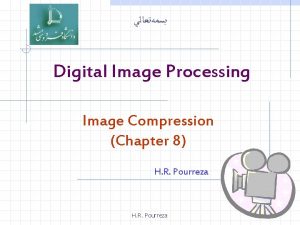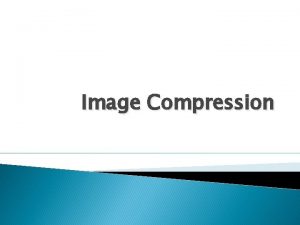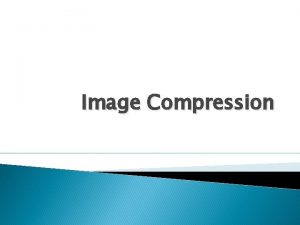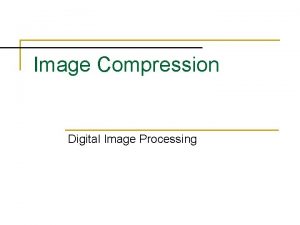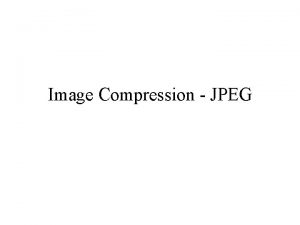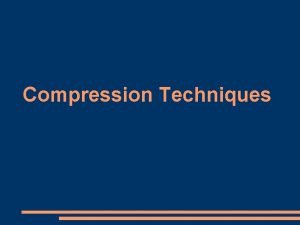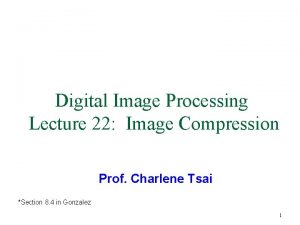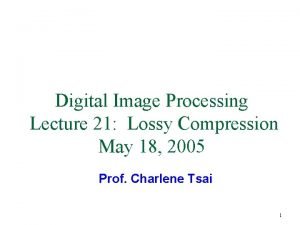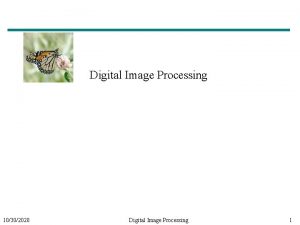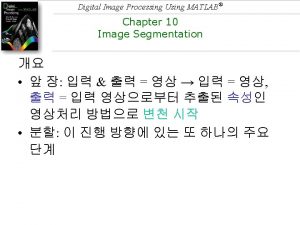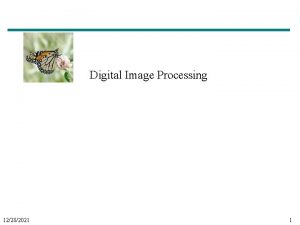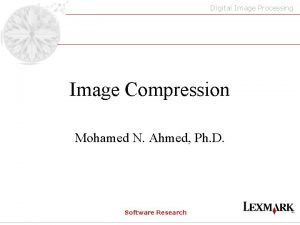Digital Image Processing Lecture 20 Image Compression May



















- Slides: 19

Digital Image Processing Lecture 20: Image Compression May 16, 2005 Prof. Charlene Tsai 1

Before Lecture … n Please return your mid-term exam. 2

Starting with Information Theory n n n Data compression: the process of reducing the amount of data required to represent a given quantity of information. Data information Data convey the information; various amount of data can be used to represent the same amount of information. E. g. story telling (Gonzalez pg 411) Data redundancy Our focus will be coding redundancy 3

Coding Redundancy n n n Again, we’re back to gray-level histogram for data (code) reduction Let rk be a graylevel with occurrence probability pr(rk). If l(rk) is the # of bits used to represent rk, the average # of bits for each pixel is 4

Example on Variable-Length Coding n n Average for code 1 is 3, and for code 2 is 2. 7 Compression ratio is 1. 11 (3/2. 7), and level of reduction is 5

Information Theory n n n Information theory provides the mathematical framework for data compression Generation of information modeled as a probabilistic process A random event E that occurs with probability p(E) contain units of information (self-information) 6

Some Intuition n n I(E) is inversely related to p(E) If p(E) is 1 => I(E)=0 q q n n No uncertainty is associated with the event, so no information is transferred by E. Take alphabet “a” and “q” as an example. p(“a”) is high, so, low I(“a”); p(“q”) is low, so high I(“q”). The base of the logarithm is the unit used to measure the information. Base 2 is for information in bit 7

Entropy n n n Measure of the amount of information Formal definition: entropy H of an image is theoretical minimum # of bits/pixel required to encode the image without loss of information where i is the grayscale of an image, and pi is the probability of graylevel i occurring in the image. No matter what coding scheme is used, it will never use fewer than H bits per pixel 8

Variable-Length Coding n n Lossless compression Instead of fixed length code, we use variablelength code: q n Two methods: q q n Smaller-length code for more probable gray values Huffman coding Arithmetic coding We’ll go through the first method 9

Huffman Coding n n The most popular technique for removing coding redundancy Steps: q q Determine the probability of each gray value in the image Form a binary tree by adding probabilities two at a time, always taking the 2 lowest available values Now assign 0 and 1 arbitrarily to each branch of the tree from the apex Read the codes from the top down 10

Example in pg 397 n The average bit per pixel is 2. 7 q q n n Much better than 3, originally Theoretical minimum (entropy) is 2. 7 Gray value Huffman code 0 00 1 10 2 01 3 110 4 1110 5 11110 6 How to decode the string 7 1101111100111110 Huffman codes are uniquely decodable. 111110 111111 11

LZW (Lempel-Ziv-Welch) Coding n n n Lossless Compression scheme for Gif, TIFF and PDF For 8 -bit grayscale images, the first 256 words are assigned to grayscales 0, 1, … 255 As the encoder scans the image, the grayscale sequences not in the dictionary are place in the next available location. The encoded output consists of dictionary entries. 12

Example n … 256 ---- 511 … … A 512 -word dictionary starts with the content … n Consider the 4 x 4, 8 -bit image of a vertical edge Dictionary location Entry 39 39 126 0 0 39 39 126 1 1 39 39 126 126 255 --- 13

To decode, read the 3 rd column from top to bottom 14

Run-Length Encoding (1 D) n n Lossless compression To encode strings of 0 s and 1 s by the number or repetitions in each string. A standard in fax transmission There are many versions of RLE 15

(con’d) n n Consider the binary image on 011000 the right 001110 Method 1: 111001 (123)(231)(0321)(141)(33)(0132) 0 1 1 0 Method 2: 000111 100011 (22)(33)(1361)(24)(43)(1152) For grayscale image, break up the image first into the bit planes. 16

Problem with grayscale RLE n n Long runs of very similar gray values would result in very good compression rate for the code. Not the case for 4 bit image consisting of randomly distributed 7 s and 8 s. One solution is to use gray codes. See page 400 -401 for an example 17

Example in pg 400 n For 4 bit image, q q n Binary encoding: 8 is 1000, and 7 is 0111 Gray code encoding: 8 is 1100 and 7 is 0100 Bit planes are: Uncorrelated Highly correlated 0 0 1 1 0 0 0 0 1 1 0 1 0 1 0 0 0 1 0 1 1 0 0 0 0 1 0 1 1 0 0 0 0 1 0 0 0 th, 1 st, and 2 nd binary bit plane 3 rd binary bit plane 0 th and 1 st gray code bit plane (replace 0 by 1 for 2 nd plane) 3 rd gray code bit plane 18

Summary n Information theory q n Measure of entropy, which is theoretical minimum # of bits per pixel Lossless compression schemes q q q Huffman coding LZW Run-Length encoding 19
 Spatial and temporal redundancy in digital image processing
Spatial and temporal redundancy in digital image processing Lossless image compression matlab source code
Lossless image compression matlab source code 472
472 Jpeg in digital image processing
Jpeg in digital image processing Histogram processing in digital image processing
Histogram processing in digital image processing Neighborhood processing in image processing
Neighborhood processing in image processing A generalization of unsharp masking is
A generalization of unsharp masking is Point processing in image processing
Point processing in image processing Point processing
Point processing Morphological processing in digital image processing
Morphological processing in digital image processing Image transform in digital image processing
Image transform in digital image processing Linear position invariant degradation
Linear position invariant degradation Image segmentation in digital image processing
Image segmentation in digital image processing Image sharpening and restoration
Image sharpening and restoration Image geometry in digital image processing
Image geometry in digital image processing False contouring
False contouring Digital image processing
Digital image processing Maketform
Maketform Noise
Noise Image processing lecture notes
Image processing lecture notes


